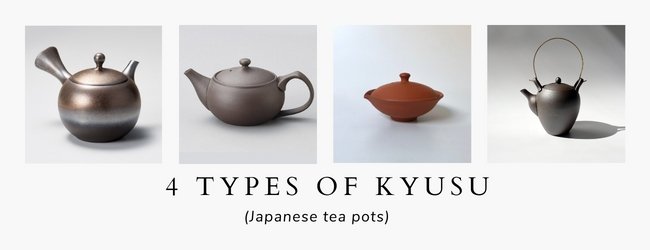急須(日本語では「ティーポット」)の種類の違いがよくわからない場合は、次の簡単なガイドをご覧ください。
1.横手の急須
意味:横手の急須 (よこでの急須) は文字通り「横手の急須」を意味します。左利き用の横出の急須もございます。
デザイン:横手の急須は、注ぎ口に対して90度の角度で円筒形の持ち手を持つのが一般的です。もともとこの形状は、亭主が客の横や後ろからお茶を注ぐのではなく、畳に座って客と向かい合ってお茶を注ぐ際に注ぎやすいように作られました。
用途:日本で煎茶を淹れる際に広く用いられています。少量ずつ複数のカップに素早く注ぐ際に効率よく注げるよう設計された形状です(注ぎ始めよりも注ぎ終わりのほうが濃いお茶になる傾向があります)。
2.後手の急須
意味:後手の急須、文字通り「後ろ手の急須」。
デザイン:このタイプのティーポットには、注ぎ口の反対側に丸いハンドルが付いています。
用途:おそらく世界で最も広く使われているタイプで、日本でも使用されています。主に伝統的な「西洋式」のお茶(葉数が少なく、湯量が多く、蒸らし時間が長い)に淹れるお茶に使用されます。
3.宝瓶(ほうひん)
意味:宝瓶(ほうひん)は文字通り「宝の器」
デザイン:宝瓶とは、主に玉露や高級煎茶を淹れる際に用いられる、取っ手のない急須のことです。他の急須に比べて注ぎ口が広いのも特徴です。取っ手がなくても、玉露は60度以下のお湯で淹れるので、火傷の心配もありません。
篩のない宝瓶のバリエーションとして絞り出し急須があります(ただし、これに取っ手が付いている場合もあります)。
用途:玉露や高級煎茶に最適です。注ぎ時間を速くすることで、抽出時間を細かくコントロールでき、完璧な一杯をお楽しみいただけます。
4. 上手の急須、土瓶
意味: 上手の急須、文字通り「上手の急須」。土瓶とも呼ばれます。煎茶道の用語では文字通り「土瓶」です。
デザイン:この急須は、本体の上部に取っ手が付いたやかんのような形をしています。日本の他の急須に比べてサイズが大きいため、大勢の人にお茶を出すときに便利です。
用途:ほうじ茶や番茶などのお茶や、たくさんのお客様にお茶を出すときにおすすめです。








4件のコメント
I love your site. I have a small teapot is it a Kyusu teapot and can it be used for Green Tea. Thank you
Could you tell me anything about this Japanese Teaset please? I love it and am keen to know more of its origins . It’s red glazed clay with brown/ green pattern banded detail and inset with cameo of leaves and dots . Footed handle less cups(6) and Kyusu pot . In box with Japanese letters.
Thanks
I have a tea pot similar to the side pour but bigger and the top is more recessed. If you tell me how I can send you a picture. I’d like to know more about the form of the tea pot, the history.
I bought this teapot but I don’t know what kind it is I would really like to know